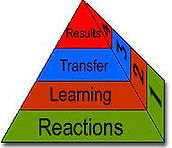
Assessment Theory
The Doctor of Ministry program of the Seventh-day Adventist Theological Seminary of Andrews University applies four levels of assessment grounded in the assessment theory developed by Donald Kirkpatrick. Recognition is given to Paul S. Brantley, Ph.D., who provided consultation to the program in the process of applying Kirkpatrick’s model of assessment.
Kirkpatrick's Four Levels of Evaluation—A Summary*
In Kirkpatrick's four-level model, each successive evaluation level is linked with the information provided by the lower level. Assessment begins with level one and then moves through levels two, three, and four. Information from each prior level serves as a base for analyzing the next level's information. Thus, each successive level represents a more precise measure and at the same time requiring a more rigorous and time-consuming analysis.
Level 1 Reactions
Just as the word implies, evaluation at this level measures how participants react to the program. Are they satisfied? What are their perceptions? Was the material relevant to their work? This type of evaluation is often called a “smile sheet.” According to Kirkpatrick, every program should at least be evaluated at this level to provide for program improvement. In addition, the participants' reactions have important consequences for learning, or change (level two). Although a positive reaction does not guarantee to learn, a negative reaction almost certainly reduces its possibility.
Level 2 Learning
Assessing at this level moves the evaluation beyond learner satisfaction and attempts to assess the extent to which students have advanced in skills, knowledge, or attitude. How have they changed? Measurement at this level is more difficult and laborious than level one. Methods range from formal to informal testing to team assessment and self-assessment.
Level 3 Transfer
This level measures the transfer that has occurred in the learners' behavior. How are they different? Evaluating at this level attempts to answer the question - Are the newly acquired skills, knowledge, or attitude being used in the everyday environment of the learner? For many, this level represents the truest assessment of a program's effectiveness. However, measuring at this level is difficult because when the change in behavior will occur varies.
Level 4 Results
Level four evaluation attempts to assess training in terms of change in the organization served. How has the organization changed? This level measures the success of the program in terms of the overall mission of an organization served by the learner. This is the overall reason for the program, yet level four results are not typically addressed because they are difficult to measure and hard to link directly with learning.
*SOURCE: Winfrey, E.C. (1999). Kirkpatrick's Four Levels of Evaluation. In B. Hoffman (Ed.), Encyclopedia of Educational Technology. Retrieved October 8, 2009, from http://coe.sdsu.edu/eet/Articles/k4levels/start.htm
4/10/2012



